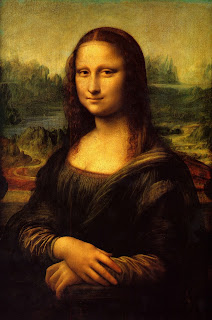My final piece was inspired by Pablo Picasso's Blue Period
work, in particular one piece called The Old Guitarist. Picasso's pieces from that
period have a monochromatic blue color palette to create a flat figure. In his
works, the figure was the focal point usually without an obvious
context.
My piece uses Picasso's monochromatic blue color
palette. Mine has some greens mixed in as well. I used the pastel to create a
soft texture. Though the majority of the piece is a soft texture, I incorporated some strong lines to create depth and play with different textures
for clothing and flesh. I also used chalk pastel on Bristol Board rather than
oil paint on canvas. In addition, I used Photoshop to create an Ipad playing
the video game Guitar Hero and a large Guitar Hero guitar. The shape of the
original piece was a traditional canvas, but mine goes beyond the rectangle to
create a unique irregular shape. The man's head is almost horizontal in relation
to his neck and is the focal point of this piece. The eye path goes from his
down to what he is looking at and then to the right towards the guitar and
finally down towards his foot at the bottom of the piece.
Since Picasso’s Blue Period pieces, do not have an
obvious story line to them; I wanted my interpretation to have an obvious one.
Therefore, my guitarist is playing an intense game of Guitar Hero using his
Ipad. This intensity is emphasized through his head facing right towards the
screen in his lap. Like Picasso’s other Blue Period work, this man is having a
private moment, but instead of having one reflecting on life’s struggles, he is
occupied with a video game. Having a video game replace a real musical
instrument adds a feeling of fake commercial product placement. This is emphasized
by the fact the figure and piece go beyond the original rectangular borders. It
is commenting on society’s concept that bigger is better and how technology isolates us. Adding the
photoshopped elements changes the tone and message of the piece. Instead of
playing a guitar alone creating a melancholy and depressed vibe, the man is alone
playing a video game creating an altered intensity to the piece.
I have greatly enjoyed this class! It has been informative and interesting.
Previously, I had only focused on traditional drawing, such as a still life,
but now can say I have created work in a range of styles. If I had not been assigned to
create different styled art, I could have easily stayed in my comfort zone. In addition, it
was interesting to learn about my artist in depth and create a piece inspired
by his work. By having this background knowledge, I am now better able to understand
the significance of his pieces. I look forward to my future art classes at Loyola!








